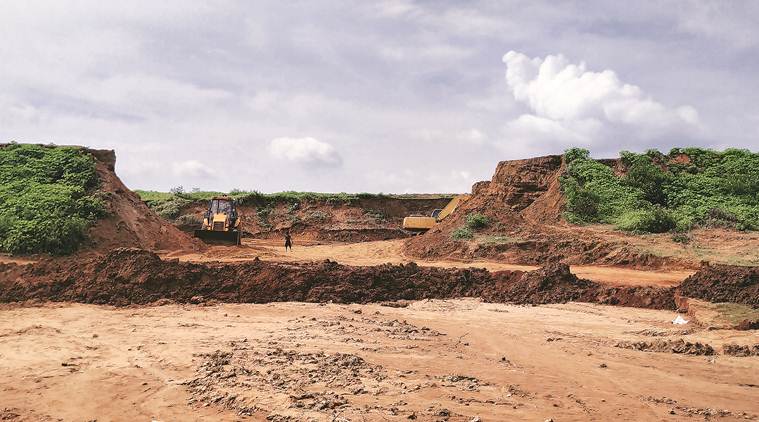Stay updated with the latest - Click here to follow us on Instagram
Of mice and men
The 42-yr wait of four Jharkhand villages for water just got extended. But did rats really fell that embankment?
 Workers clear out debris after the embankment collapse on August 28, hours after it had been inaugurated. That day was the first time there was water in the canal it lined. (Expres photo: Abhishek Angad)
Workers clear out debris after the embankment collapse on August 28, hours after it had been inaugurated. That day was the first time there was water in the canal it lined. (Expres photo: Abhishek Angad)
HOW MANY rats does it take to fell an embankment — part of a project in planning for 42 years and costing Rs 2,200 crore — in hours? How about none, say four villages in Giridh district’s Kusumraza panchayat.
Nearly a month after rat holes were cited by Jharkhand officials as the reason for the August 28 collapse of an embankment of the Konar Irrigation Project, inaugurated by Chief Minister Raghubar Das just hours earlier, villagers say the reason weren’t rodents or even a big mystery. According to them, the cause was that the embankment’s construction blocked an escape route for the Bagodar canal, increasing the pressure on it.
As officials prepare a report, farmers are worried about compensation for their paddy crop, that was inundated when the embankment broke.
Started in 1977 to provide irrigation to 85 villages in three districts, the Konar project has seen canals come up over the years but with no water in them. The embankment was meant to confine the water in the Bagodar canal and safeguard the villagers against flooding. The day it collapsed was the first time there was water in the branch canal.
The farmers here all grow paddy, corn and vegetables, and right now, depend on a rain-fed pond and well for irrigation.
After inaugurating the embankment at Banasho in Hazaribagh district, CM Das had tweeted: “… 42 saal se adhoori Konar Sinchai Pariyojna ka aaj udghatan hua. Ab Hazaribagh, Giridih aur Bokaro ke 85 gaon mein sinchai ke liye paani ki killat nahi hogi (Incomplete for 42 years, the Konar Irrigation Project was inaugurated today. Now 85 villages of Hazaribagh, Giridih and Bokaro won’t have any water scarcity for irrigation).”
Hours later, with the embankment gone, Additional Chief Secretary, Water Resources Department, Arun Kumar Singh said, “This has become clear that the left part of the 25-30 ft kuchcha embankment collapsed. There is a possibility that the breach was caused due to rat holes.”
However, supervising work in the Bagodar block, Junior Engineer, Dumri, Chittaranjan Kumar Mahato, backs the villagers’ theory, about blocked water flow increasing pressure on the embankment. “There is an escape route to maintain adequate level (of water), gates to which have to be always kept open. It appears the gates were shut. It seems a case of neglect rather than rat hole damage,” he says, adding that four of his colleagues were “suspended” after the incident.
Incidentally, exactly two years ago, Bihar Water Resources Minister Rajiv Ranjan Singh had cited rats as the reason for the collapse of a portion of an irrigation canal of the Bateswar Ganga Pump Nahar Yojana. Water resources engineers had called holes left by rats and foxes in embankments the biggest impediment in maintaining them.
In Giridih, among those whose crops were destroyed is 38-year-old Bishun Pandit of Ghoshko village, despite the fence he had put up around his 10-decimal paddy plot. “I had spent Rs 90,000 to build the fence,” he says, adding that he planned to hire labour to remove the thick layer of wet mud that now covers a portion of his land, rendering it uncultivable.
Another villager, Samshul Ansari, says most of his four-acre land was destroyed, leaving him with losses of around Rs 1.5 lakh. “The flooding also washed away the fish I had put in my pond for business.” Sadakat Ansari, the husband of Kusumraza panchayat mukhiya Javeda Khatun, says that after the water came to the canal, arrangements were to be made for transporting it to farm areas. Elaborating on their disappointment, he adds, “People had been celebrating, it was as if a long-awaited wedding had got cancelled. At least 80-85 farmers have lost their crops and we estimate total losses of around Rs 40-45 lakh.” About whether the rats had caused the breach, Ansari isn’t sure, asking if there were holes, how were the trial runs successful. While admitting that rats had sometimes caused damage to their crops, he adds, “But they are not a menace.”
On September 2, Khatun sent a letter to the Executive Engineer on their losses, seeking that the canal be cemented, a water outlet be arranged from it to farm areas, and that a footover bridge be built over the canal for villagers to use.
Officials put the total cost of repairing the embankment at Rs 37.39 lakh. “Only 30 acres of total farm land with paddy and corn crops was damaged. A five-member committee has initiated the process of giving compensation. By September end, the repair work will be completed,”said an official who did not wish to be identified.
At the work site though, Junior Engineer Mahato says it might be days before the breach is closed. “A kuchcha embankment is not a solution,” he adds. “It has to be cemented to stop any further breach.”
Villagers say they are willing to be patient. “We waited for water for 42 years, we will wait for more.”







